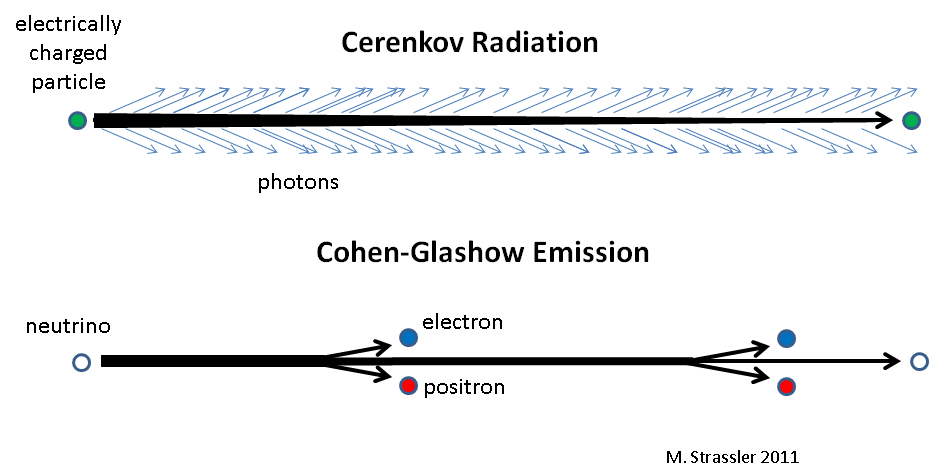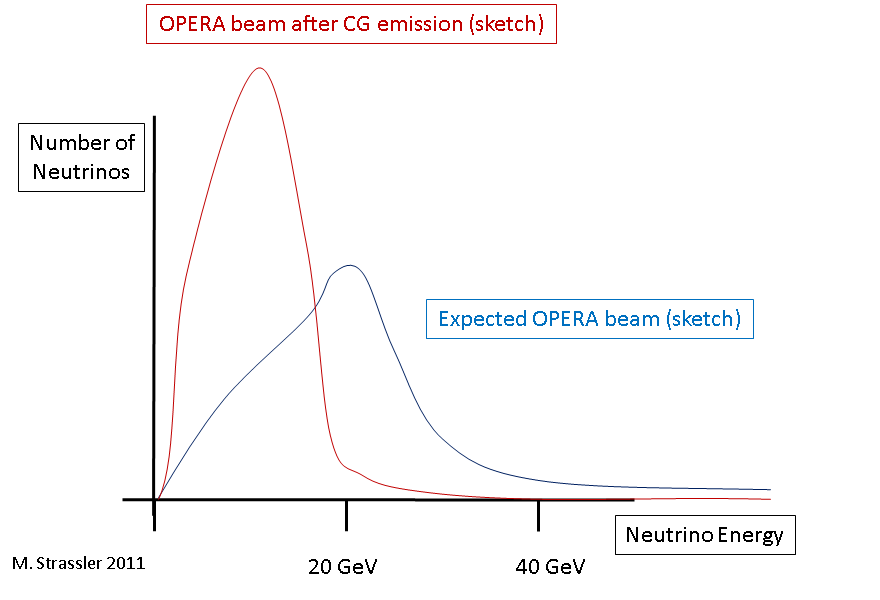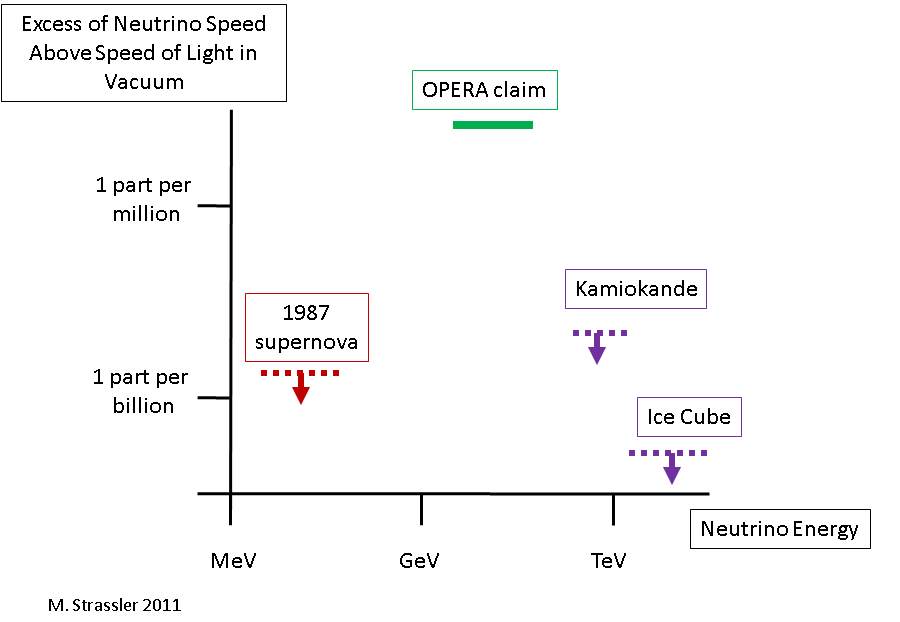Matt Strassler 10/6/11
While I was busy with last week’s LHC workshop in London, a very interesting and short paper appeared, written by two of the world’s experts on violations of “Lorentz invariance”, the symmetry of space and time that underlies Einstein’s theory of special relativity. The authors, both from Boston University, are Andrew Cohen, who is highly regarded within the community for several significant contributions to high-energy physics, including his co-authorship of the key papers that led to the theory of a composite Higgs field known as “Little Higgs”, and Sheldon Glashow (formerly at Harvard), Nobel Prize winner for his work on the weak nuclear force, and famous for many other contributions of nearly equal importance. In the 1990s, Glashow, with the late great physicist Sidney Coleman, (highly respected not only for his exceptional theoretical research but also for his beautiful scientific writing and extraordinary teaching ability), wrote two important papers on violations of Lorentz invariance. It was they (to the best of my knowledge) who pointed out the enormous value of Cerenkov radiation in testing Einstein’s relativity principles. (I’ve just written a new short article on Cerenkov radiation, and there I briefly explain how Coleman and Glashow used it previously to test Lorentz invariance.)
What Cohen and Glashow did last week was to generalize this idea to point out a new physical phenomenon (new at least to me) and use it to argue that OPERA’s result is self-inconsistent. They argue that the very effect of faster-than-light travel that OPERA claims to observe would have caused distortions in its neutrino beam that clearly were not observed. Moreover, Cohen and Glashow also pointed out that at least two other experiments studying higher energy neutrinos put even stronger constraints on the possibility of anything similar to what OPERA observed.
What I find attractive about this paper is that it is simple and elegant, making use only of very well-known properties of the weak nuclear force and quantum field theory, basic conservation of energy and momentum, relations between energy and momentum and velocity for the various particles involved, and a small number of prior experimental results. It relies on very few assumptions about the nature of space and time. And it makes use of a novel (or at least poorly known) physical mechanism. Finally, it is a classic theorists’ paper, cornering the OPERA result, like a trial lawyer cleverly and swiftly tricking a thief into a self-contradiction.
Before we get into the argument, let’s get a couple of things straight. First, neutrinos from supernova 1987a (as I explained here) arrived so close in time to the light from the supernova that their speed cannot have exceeded that of light by more than a few parts per billion. The energy of the supernova neutrinos was a few hundred times smaller than that of the neutrinos in the OPERA beam, so we cannot conclude from this observation that OPERA’s result is wrong, but it is something to keep in mind. If OPERA is right, the effect they observe must be growing with the energy of the neutrino.
You might wonder whether the supernova neutrinos are of one type, and might have one speed, while those at OPERA might be a different neutrino-type and travel at a different speed. This possibility, as Coleman and Glashow pointed out in their papers from the 1990s, is excluded by the various experiments on neutrino oscillations, whose internal self-consistency would be badly broken if different types of neutrinos traveled at speeds as different as would be required to reconcile the supernova neutrinos with OPERA’s neutrinos. In fact, the constraints on the differences between the speeds of different neutrino types is at the level of ten parts per billion trillion! We can forget about that possibility being important.
From these two paragraphs we conclude that if OPERA is right, the speed of all three types of neutrinos must increase with energy, differing from light speed by a few parts per billion or less for neutrinos with 0.01-0.04 GeV, and differing at a few parts per hundred thousand for OPERA’s neutrinos, with 10-40 GeV of energy. (For a reminder of what a GeV is, click here.)
The Cohen-Glashow argument
If you know about Cerenkov radiation (if not, read about it here), you know that any electrically-charged particle traveling faster than the speed of light will radiate bright light. Now that’s not supposed to be able to happen in empty space (vacuum), since nothing (if Einstein’s relativity is precisely correct) should be able to go faster than that. But in water, the speed of light is only three-quarters of what it is in vacuum, and high-energy particles can easily go faster than light travels in water. Muons from cosmic ray showers (sprays of particles created when high-energy particles from outer space hit an atomic nucleus somewhere high in the atmosphere) do it in droves, raining down on the ocean at close to the speed of light in vacuum. Moreover, Cerenkov light is used all the time in particle physics experiments; it serves as one of the best ways to detect and measure the properties of high-speed particles that can travel macroscopic distances.
Now neutrinos are not electrically charged, and at first glance they will not emit Cerenkov radiation. But this is not quite true, because neutrinos do have a very small magnetic moment (i.e., they act like extremely weak magnets) that is generated by a quantum effect involving the electromagnetic and weak nuclear forces. Consequently they too will emit a very dim form of Cerenkov radiation. It is too dim, however, to affect the OPERA measurement.
But then Cohen and Glashow point out that, for neutrinos, there’s a more important process… not obviously more important, and still small… but big enough. Just barely, too. This is a nice example of why in the end one has to stop talking and carry out honest and detailed calculations in physics; it often happens that you can’t guess the answer, and you have no choice but to follow the equations to their logical conclusion. The basic idea is that a neutrino that travels fast enough can potentially lose energy by emitting a particle and a corresponding antiparticle through effects of the weak nuclear force. Specifically, if a neutrino could travel faster than electrons could travel, then with sufficient energy the neutrino could emit an electron and a positron.
Well, are the OPERA neutrinos traveling faster than electrons can travel? Yes, because of what we know about electrons from Cerenkov radiation. We know that electrons at energies below a TeV cannot travel faster than the speed of light in vacuum by more than one part in a thousand trillion, because if they could, they would Cerenkov radiate even in vacuum. In this case we would never observe the high-energy electrons that we do in fact see in experiments. And therefore, if neutrinos travel faster than light by a few parts per hundred thousand, then they likewise travel faster than the maximum speed of electrons by about the same amount. It follows that for sufficiently high energy, neutrinos can spit off an electron-positron pair.

This process is like Cerenkov radiation, but only in part (see Figure 1). Cerenkov light is emitted as large numbers of photons, of many frequencies, virtually continuously. It is a process one can (and Heaviside apparently did) calculate in classical physics of the 19th century. But the type of radiation process discussed by Cohen and Glashow is very different. Because the weak nuclear force is indeed very weak in this context, an electron-positron pair is emitted only rarely as the neutrino travels along, with the first emission happening after some tens of kilometers; it is something that happens in discrete jumps, an inherently quantum mechanical phenomenon. It perhaps deserves its own name, so in this article I will call it Cohen-Glashow emission, or CG emission for short.
Now the calculation begins: how often does CG emission occur? And how much energy is lost along the way? According to Cohen and Glashow, if OPERA were correct — if neutrinos could travel faster than the speed of light in vacuum by the amount claimed by OPERA — then the higher-energy neutrinos among them could not have made the 730 kilometer trip from CERN to the Gran Sasso laboratory without losing a significant fraction of their energy. In fact, with each CG emission the typical high-energy OPERA neutrino loses 3/4 of its energy in one step! More precisely, the OPERA beam has a significant fraction of its neutrinos in the 20-40 GeV range, along with others down below 20 GeV. CG emission over 730 kilometers ought to have severely depleted the higher-energy neutrinos, moving almost all of them down well below 20 GeV. (The number they actually quote in the paper is even lower — 12.5 GeV — but I’m being a bit conservative here, see below.) This energy redistribution (see Fig. 2) would have been easily observed by OPERA. In fact, OPERA shows data in their paper (see Figure 13) indicating they have hordes of neutrinos above 20 GeV. Quoting from the OPERA paper “Data were then split into two bins of nearly equal statistics, including events of energy lower or higher than 20 GeV. The mean energies of the two samples are 13.9 and 42.9 GeV.”

And thus the claim of Cohen and Glashow is that OPERA is inconsistent with itself — that it could not have seen a speed excess without an energy distortion, the latter being easier to measure than the former, but not observed. The upshot, then, is that OPERA’s finding that its neutrinos arrived earlier than expected cannot be due to their traveling faster than the speed of light in vacuum. Something is probably wrong with OPERA’s expectation, not the neutrinos.
One loophole you might worry about is that OPERA claims a measurement of a 60 nanosecond early arrival for its neutrinos. But all measurements come with uncertainties, and the uncertainties on the OPERA measurement are 10 to 15 nanoseconds, depending on how you combine the various sources of uncertainty. So while 60 might be the preferred experimental value, 30 nanoseconds might be the true value in nature. But my estimate is that even if OPERA’s result were an observation of a 30 nanosecond effect, the impact of CG emission on the neutrino beam would still be very significant. (The 12.5 GeV number in the paper would move up close to 20 GeV.) It doesn’t appear it would be possible for both the Cohen-Glashow paper and OPERA’s result to be correct simultaneously.
But these details almost don’t matter, because Cohen and Glashow then put another chunk of powerful evidence on the table. They point out that neutrinos have been observed, at two other experiments, SuperKamiokande and IceCube, 100 to 1000 times more energetic than the neutrinos in OPERA’s beam. These neutrinos come out of the earth having traveled many hundreds or thousands of kilometers across interior of the planet. The fact that these neutrinos did not lose most of their energy while traveling all that distance implies that they, too, did not undergo CG emission. In short, they must have traveled very close to, and conservatively no more than about fifteen parts per billion faster than, the speed of light in empty space. (The limit from IceCube data may be as good as ten parts per trillion!)
And so where do we stand, according to Cohen and Glashow?
- We have supernovas neutrinos with energies 100–1000 times smaller than those in OPERA’s beam that travel within a few parts per billion of light speed.
- We have neutrinos with energies 100–1000 times larger than OPERA’s that travel within a few tens of parts per billion of light speed.
- We have OPERA, which observes an effect of 20 parts per million, and yet if neutrinos traveled as fast as that, OPERA should have seen its high-energy neutrinos depleted before they even arrived, due to CG emission, but did not.
Can we conclude that the OPERA result is impossible? No. Implausible? Deeply.

Are there loopholes? Of course there are — theorists are very clever — and so it is too early to say that the curtain on OPERA has been lowered for good. I’m sure various people have one or another way to shut off Cerenkov-type radiation. But the story on the OPERA stage is beginning to look dreadfully contrived.
[I would like to thank Andy Cohen for clarifying a few points in his paper for me.]


5 Responses
How does an electron, a point, radiate a photon, a particle? If a neutrino has never traveled at faster than light any prediction is possible. Last neutrinos traveling at the speed of light have infinite mass, why is this not a big deal?
These are common confusions. They are addressed in much more detail in my book.
An electron is not a point. Both photons and electrons are more like ripples in fields — the photon is a ripple in the electromagnetic field, an electron is a ripple in the electron field. The interactions among these ripples (or “wavicles”, a term I prefer) is described by quantum field theory. It’s easy for a ripple of one type of interact with a ripple of another type; for instance, loud sound waves can cause waves on water.
About your last question: there are two types of mass that people often get mixed up. The first, rest mass, is independent of speed; a neutrino’s rest mass is always extremely small, no matter how fast it moves. Rest mass is intrinsic to objects, and all observers agree on how much each type of particle has. The second kind, relativistic mass, depends on speed, but all particles have larger and larger relativistic mass when their speed (from our perspective) approaches the speed of light. Relativistic mass is perspective-dependent; if a neutrino passes us at nearly the speed of light, its relativistic mass is very large from our perspective, but from the point of view of someone traveling along with the neutrino, its relativistic mass is very small.
In summary, the intrinsic mass of a neutrino is always very small. Its relativistic mass is perspective-dependent, and therefore, even though it can be large from the point of view of someone whose speed relative to the neutrino is near the speed of light, it is of far less importance.
I don’t understand your statement: “If a neutrino has never traveled at faster than light any prediction is possible.” You’ll have to explain that more clearly before I can help with that one.
Great stuff, Matt. I have two questions: First, the relevant Feynman diagram here is neutrino emitting a virtual (time-like) Z which then decays into e+e-, right? Second, since the Z is virtual, it doesn’t have a well-defined velocity even if it’s four-momentum was fully known, right?
Well, that’s a little ambiguously stated. The four-momentum of the Z would only be known if the electron-positron pair were measured. But if they aren’t measured, then the four-momentum isn’t known.
But if where you are headed is to see if the velocity of the Z is faster than light, you can stop that line of thinking with this observation: when virtual photons are exchanged between two electrons that bounce elastically off each other, the velocity of those virtual photons is — if you calculate it the way you’re trying to do it — infinite. (Momentum is exchanged; energy is not; so v = p/E = infinite.) Of course that’s the point: virtual photons aren’t particles, and if you start to think about them that way you will get into trouble. See my post on virtual particles: http://profmattstrassler.com/articles-and-posts/particle-physics-basics/virtual-particles-what-are-they/